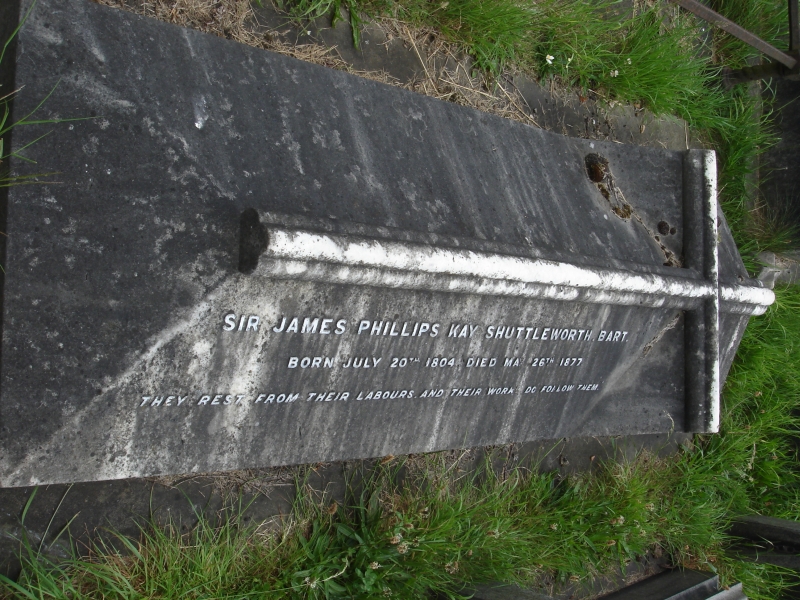- Sir James Kay-Shuttleworth, 1st Baronet
image_size = 150px
caption = Funerary monument, Brompton Cemetery, London
birth_name =
birth_date =20 July ,1804
birth_place =Rochdale ,Lancashire
death_date =26 May ,1877
death_place =
death_cause =
resting_place =
resting_place_coordinates =
residence =
nationality = English
other_names =
known_for =
education =
employer =
occupation =
home_town =
title =
salary =
networth =
height =
weight =
term =
predecessor =
successor =
party =
boards =
religion =
spouse =
partner =
children =
parents =Robert Kay
relatives =
website =
footnotes =Sir James Phillips Kay-Shuttleworth, 1st Baronet (
20 July ,1804 –26 May ,1877 ) was an Englishpolitician andeducationalist .Early life
He was born James Kay at
Rochdale ,Lancashire , the son ofRobert Kay .Career
At first engaged in a Rochdale bank, in 1824 he became a medical student at the
University of Edinburgh . Settling inManchester about 1827, he was instrumental in setting up theManchester statistical Society . He worked for theAncoats and Ardwick Dispensary . While still known simply as Dr. James Kay, he wrote "The moral and physical condition of the working-class employed in the cotton manufacture on Manchester " (1832), which was cited byFriedrich Engels in " [http://www.marxists.org/archive/marx/works/1845/condition-working-class/index.htm Condition of the Working Class in England in 1844] ". The experience which he thus gained of the conditions of the poor in the Lancashire factory districts, together with his interest in economic science, led to his appointment in 1835 as poor law commissioner inNorfolk andSuffolk and later in the London districts. In 1839 he was appointed first secretary of the committee formed by the Privy Council to administer the Government grant for the public education in Britain.He is remembered as having founded at
Battersea, London , in conjunction withE. Carleton Tufnell , the first training college for school teachers (1839-1840); and the system of national school education of the present day, with its public inspection, trained teachers and its support by state as well as local funds, is largely due to his initiative.Later life
A breakdown in his health led him to resign his post on the committee in 1849, but subsequent recovery enabled him to take an active part in the working of the central relief committee instituted under Lord Derby, during the
Lancashire cotton famine of 1861-1865. He was created a baronet in 1849. Until the end of his life he interested himself in the movements of the Liberal Party in Lancashire, and the progress of education. His "Physiology, Pathology and Treatment of Asphyxia" became a standard textbook, and he also wrote numerous papers on public education. He was also one of the key figures in the foundation of the Girls' Public Day School Company and was a member of their Council until shortly before his death.He died in 1877 and is buried in
Brompton Cemetery , London.Personal life
In 1842 he married Lady
Janet Shuttleworth , assuming by royal licence his bride’s name and arms.His son, Sir
Ughtred James Kay-Shuttleworth (1844-1939), became a well-known Liberal politician, sitting in parliament for Hastings from 1869 to 1880 and for theClitheroe division of Lancashire from 1885 till 1902, when he was createdBaron Shuttleworth . He wasChancellor of the Duchy of Lancaster in 1886, and secretary to theAdmiralty in 1892-1895.References
*cite book | author=Engels, Friedrich, & McLellan, David | title=The Condition of the Working Class in England | location=New York | publisher=Oxford University Press | year=1999 | id=ISBN 0-19-283688-9
*1911
Wikimedia Foundation. 2010.

